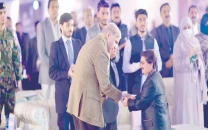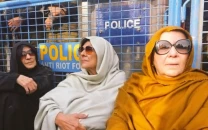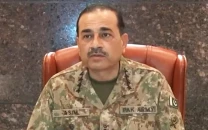A glance at the inner workings of Lahore biennale
Qudsia Rahim and Iftikhar Dadi spill the beans on vision behind the annual showcase

Express Tribune (ET): Let’s start at the core of it all and talk about your choice of the curator, Hoor Al Qasimi?
Ifktihar Dadi(ID): Hoor’s region overlaps with ours. In the sense that if we are doing a biennale in Lahore it has to relate to all broader concerns, and a part of these broader concerns are the links that Lahore and Punjab and this area of the world have had with its surroundings, which included South Asia and Central Asia, Iran, Turkey and the Middle East. She has been the director of the Sharjah Art Foundation, which has been a major platform, having hosted many, many shows of both groups and individuals.

Qudsia Rahim(QR): We are an academically inclined organization. We take part in visual engagements with an understanding of the region and how artists respond to the region. I think this is very important and is our responsibility. There were many factors affecting our decision to have Hoor onboard, she is from the region and understands our strengths and challenges, she has also worked closely with many artists from Pakistan, so she is not completely unfamiliar to us.
ET: So between the first and the second biennale there has been a big difference. Obviously Hoor is one big difference but there is also the idea of a change in focus.
ID: So, of course, the first biennale was also a first for us even though the first biennale had more than 50 artists and some major projects, but we wanted to focus on South Asia. In the first biennale there were artists participating from Bangladesh, India, Sri-Lanka and Iran as well as other words part of the immediate surrounding region and also many Pakistani artists and the Pakistani diaspora. However, in this biennale there was more focus on Central Asia and West Asia and the Middle East and Africa and their diasporas and that is all chosen according to a historical context.
ET: Looking ahead, what do you think would be a natural next step for the Lahore Biennale Foundation?
QR: I think it is really important to be introspective and that’s what we did after the first biennale as well. After receiving feedback of the first biennale, it was through introspection that we conceived the second biennale. We will consider the learnings of the second biennale to plan ahead. At this time we are not able to reveal too much, simply because we need time to assess the lessons of the second biennale.

ID: I think that the basic Principles are the same. We need to think about Lahore and what makes sense for this place. Above all that's the value driving the biennale and we look at legacies from the past as well. If you look at Central Asia and West Asia and the Middle East, do we really need to revisit them in the same intensive way next time? Maybe next time we need to think about other ways of looking at Lahore and the questions that arise.
ET: So the idea of building biennales through art and academia, involving students and getting out to the public, you think it is where you wanted it to be?
ID: I think audiences should not be pre-constituted. They are created and the more we engage the more the potential grows in attracting a diverse group of people and that's the task ahead of us. We have had many art students and Lahoris attend the first biennale and then they were also there for the Tariq Ali talk this time around. So there is room to grow always and we know that it will keep happening.
QR:Lahore Biennale Foundation is a young organization. At this time we cannot start comparing ourselves to more established organizations. It takes time for young organisations to mature and engage with their audience. All these things take time and you go through the teething issues. Public programming has always been an integral part of LBF. Certainly, we hope to create more focused programming for students and young professionals from now until the third biennale.
ID: Also, I have to say that I am a big admirer of the Lahore scene. But one of the criticisms I might have for the Lahore art students is that they are trained very well as Studio artists but they don't study other disciplines like sociology, history and cultural studies. So in the academic program, we don’t focus solely on art, but more broadly on the wider historical-cultural legacies and emerging issues. As an artist you might or might not engage with these things in your work but these have the potential to make the art work deeper, more complex, and more relevant. A good academic program associated with the biennale can contribute in this way to the wider domestic art world.
Have something to add to the story? Share in the comments below.



















COMMENTS
Comments are moderated and generally will be posted if they are on-topic and not abusive.
For more information, please see our Comments FAQ